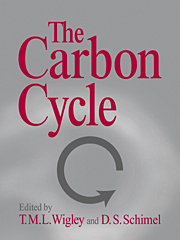Book contents
- Frontmatter
- Contents
- Preface
- Acknowledgments
- Contributors to the 1993 Global Change Institute
- I INTRODUCTION
- II THE MISSING CARBON SINK
- 3 Carbon Dioxide Emissions from Fossil Fuel Consumption and Cement Manufacture, 1751–1991, and an Estimate of Their Isotopic Composition and Latitudinal Distribution
- 4 Emissions of Carbon from Land-Use Change
- 5 The CO2 Fertilizing Effect: Relevance to the Global Carbon Cycle
- 6 Soils and the Global Carbon Cycle
- 7 Grasslands and the Global Carbon Cycle: Modeling the Effects of Climate Change
- 8 Constraints on the Atmospheric Carbon Budget from Spatial Distributions of CO2
- 9 Estimating Air–Sea Exchanges of CO2 from pCO2 Gradients: Assessment of Uncertainties
- 10 Atmospheric Oxygen Measurements and the Carbon Cycle
- 11 A Strategy for Estimating the Potential Soil Carbon Storage Due to CO2 Fertilization
- III PALEO-CO2 VARIATIONS
- IV MODELING CO2 CHANGES
- Part V Appendixes
- Index
5 - The CO2 Fertilizing Effect: Relevance to the Global Carbon Cycle
from II - THE MISSING CARBON SINK
Published online by Cambridge University Press: 04 December 2009
- Frontmatter
- Contents
- Preface
- Acknowledgments
- Contributors to the 1993 Global Change Institute
- I INTRODUCTION
- II THE MISSING CARBON SINK
- 3 Carbon Dioxide Emissions from Fossil Fuel Consumption and Cement Manufacture, 1751–1991, and an Estimate of Their Isotopic Composition and Latitudinal Distribution
- 4 Emissions of Carbon from Land-Use Change
- 5 The CO2 Fertilizing Effect: Relevance to the Global Carbon Cycle
- 6 Soils and the Global Carbon Cycle
- 7 Grasslands and the Global Carbon Cycle: Modeling the Effects of Climate Change
- 8 Constraints on the Atmospheric Carbon Budget from Spatial Distributions of CO2
- 9 Estimating Air–Sea Exchanges of CO2 from pCO2 Gradients: Assessment of Uncertainties
- 10 Atmospheric Oxygen Measurements and the Carbon Cycle
- 11 A Strategy for Estimating the Potential Soil Carbon Storage Due to CO2 Fertilization
- III PALEO-CO2 VARIATIONS
- IV MODELING CO2 CHANGES
- Part V Appendixes
- Index
Summary
Abstract
The CO2 fertilizing effect on vegetation growth arises from primary effects of CO2 concentration on photosynthetic CO2 fixation, suppression of photorespiration (and possibly of dark respiration), and reduction in stomatal conductance. These mechanisms increase the efficiency of use of growth-restricting inputs of light, water, and nitrogen in the formation of dry matter. It is of critical significance that the C:N ratio of plant tissues varies considerably when CO2 is varied. The relative response of plant stand seasonal growth to high CO2 is typically similar to that which would be calculated on basic photosynthetic biochemical and stomatal diffusion grounds. Researchers are still determining the full extent of various negative and positive feedbacks and other factors that accentuate or attenuate the propagation of this primary response into the size of live and dead C pools. However, on the basis of present evidence it seems unjustified to assume that all such modifiers act to annul completely the primary stimulus of high CO2 in terms of increase in C pool sizes. Indeed, the likely magnitude of the CO2 fertilizing effect is such that it can comfortably account for the “missing carbon sink” of approximately 1–2 Gt C/yr, according to several independent terrestrial C cycle models.
For modeling the response of net primary production (NPP) to CO2, there are five approaches. The once common approach of assuming a flat response (i.e., nonresponse) above the preindustrial CO2 concentration of 280 μmol/mol is highly unlikely to be correct.
- Type
- Chapter
- Information
- The Carbon Cycle , pp. 77 - 92Publisher: Cambridge University PressPrint publication year: 2000
- 3
- Cited by



